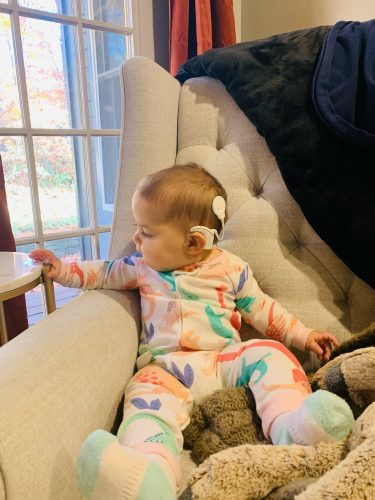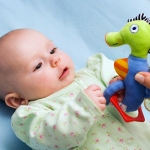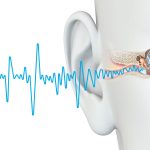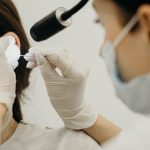At six months old, Luna James Pray was the youngest child to undergo bilateral cochlear implants at Mass Eye and Ear after being born with profound deafness. Watch the video below or click here to watch Luna’s story.
Two days after their healthy baby girl Luna James was born last March, Emily and Brian Pray sensed something was wrong.
The signs were subtle: Luna wouldn’t react to loud noises her parents made around their Maine home and she wasn’t startled when their dog barked.
“Call it mother’s intuition,” Emily told Focus. “I remember turning to Brian and my parents and saying to them, ‘I think she’s deaf.’”
Two weeks after her home birth, Luna received a newborn hearing screening at a local hospital. She did not pass. Her parents hoped the problem was temporary, like fluid in the ears, and brought her to a local audiologist, who informed them the issue may be more serious.
That’s when a family friend recommended the Prays visit Mass Eye and Ear. Within two weeks, Luna would undergo auditory brainstem response (ABR) testing so the family could learn the extent of Luna’s hearing loss.

“In my first test with Luna, I was not able to detect any hearing,” said Mandy Theisen, AuD, CCC-A, an audiology manager at Mass Eye and Ear. “We diagnosed Luna with profound sensorineural hearing loss. We knew it was permanent and not likely to improve without medical intervention.”
Back home, the Prays absorbed the news, anxious of what it might mean for their daughter’s future.
“The worst part of it all was she hadn’t heard our voices yet,” said Emily. “She hadn’t heard us say I love you, and that was really hard.”
Earlier intervention brings better outcomes
Fewer than two out of every 1,000 babies in the United States are born with a significant hearing loss, and about one out of two cases are due to genetic causes. The most common type of hearing loss, sensorineural hearing loss, is irreversible, and often originates from abnormal or absent sensory cells within the inner ear.
According to Dr. Theisen, a child’s ability to develop speech and language may be hindered without a medical intervention like a hearing aid or cochlear implant in addition to speech therapy and other resources.
“The earlier we identify how a baby hears, the better we can give that child access to speech and language in their family and educational environments so they can thrive and learn to talk like every other child,” she said.
In her earliest days, Luna likely only detected sound through vibrations. These vibrations sometimes provide speech cues through the hearing aids, but those devices couldn’t be relied on to help Luna develop expressive and receptive language. This prompted Luna’s parents to explore the possibility of cochlear implants.
A cochlear implant consists of two parts, one gets placed internally through surgery, and the second rests externally outside the ear. The internal part takes the place of the cochlea, the organ responsible for sending sound to the brain. The external device picks up acoustic sound through a microphone and sends an electrical signal to the internal piece, which stimulates the hearing nerve and enables sound information to travel up to the brain.
Ultimately, it is the family’s choice on how they want their child to develop language. For example, some parents opt to have their child learn and develop visual language through American Sign Language (ASL). Some families prefer a combination of both visual and spoken language. The Prays felt a preference for Luna to develop spoken language along with ASL in a bilingual approach, and as such, were interested in cochlear implants, which brought them back to Mass Eye and Ear.
An ideal candidate
At only eight weeks old, Luna underwent an MRI at Mass Eye and Ear to examine the structures in her ear. Daniel Lee, MD, director of pediatric otology and neurotology, examined the MRI, which revealed that Luna had normal inner ear anatomy, making her a candidate for cochlear implants.
Mass Eye and Ear had never had a child so young undergo cochlear implant surgery; the youngest had been about nine months old. Last year, the U.S. Food and Drug Administration lowered its recommended starting age for cochlear implants from 12 months to nine months.
Luna was a full-term healthy infant and was extremely interactive and receptive to visual cues for such a young child. The family was very motivated to consider cochlear implant surgery as soon as this could be safely considered from an anesthesia perspective. Fortunately, the inner ear is adult size at birth, so there were no surgical concerns for performing it on a child Luna’s age.
“Baby Luna is an incredibly special little girl,” said Dr. Lee. “Our impression of not only her but her parents was that she had tremendous potential to do well with bilateral cochlear implants.”
Luna’s first sounds
Luna’s surgery with Dr. Lee took place in mid-October before she turned seven months old. The surgery was a success and the Prays recalled everyone at the hospital treating Luna like she was their own daughter. After a two-week healing period, Luna returned to Mass Eye and Ear for her cochlear implant activation.
Luna’s audiologists Dr. Theisen and Rupal Bhakta, AuD, CCC-A, began the activation in the right ear at a soft and conservative level, which they would gradually instruct the family to increase over a week.
Once the device was activated, Brian held Luna as Emily kneeled in front of her and spoke to her. Immediately, Luna cried. <watch Luna’s cochlear implant activation above.>
Because babies that young cannot describe to audiologists what they are hearing, crying is a natural reaction to the unknown experience of hearing sound for the first time.
“We never want to see her cry, but this was a situation where it was okay,” said Emily.

Luna went home that day with the devices activated and has been thriving ever since. She is reacting to her parents speaking and has left a lasting impression on her surgeon, Dr. Lee.
“I believe that Luna will exceed our expectations,” Dr. Lee said. “She has phenomenal support at home and that’s really key — it all starts and ends in the home with the parents.”
Brian said his family feels blessed Luna was able to get the surgery so young, to give her every opportunity to thrive. His advice to others in their situation is to get creative with their parenting and to make sure to form a visual connection with their child from early on, whether it’s dancing or smiling, leading up to whatever hearing path they take. Emily added that parents should know they and their child are resilient, and to enjoy every minute they have together regardless of the diagnosis.
As for what it felt like to have the youngest child implanted and activated with cochlear implants in the hospital’s history, her parents thought it was fitting. Luna was born to be a pioneer.
“We knew she was going to lead the way somehow,” said Emily. “We say she’s going to be the first deaf astronaut, so this is a good starting point,”
Watch more of Luna’s story in this video, and in a segment on WCVB.




My daughter is profoundly deaf- years ago she suffered the HIV virus-then had a reaction to steroids. Is there any new treatment she could be offered please- she is 47 years of age and in very good health now thankyou Jenny Rolfe (UK)
Do people age 90 benefit from an implant ?
Luna is absolutely precious. What gorgeous expressive eyes and what a smile. All the best to her and her parents.
Just precious.
Thanks for reading and watching, and your comment Judith…. Luna is an amazing little girl!